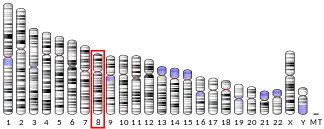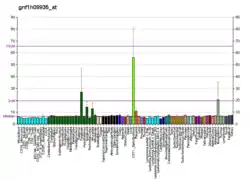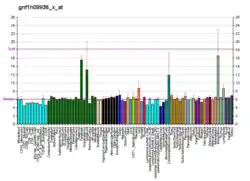CSMD1
CSMD1 CUB and Sushi multiple domains 1 is a protein that in humans is encoded by the CSMD1 gene.[5]
| CSMD1 | |||||||||||||||||||||||||||||||||||||||||||||||||||
|---|---|---|---|---|---|---|---|---|---|---|---|---|---|---|---|---|---|---|---|---|---|---|---|---|---|---|---|---|---|---|---|---|---|---|---|---|---|---|---|---|---|---|---|---|---|---|---|---|---|---|---|
| |||||||||||||||||||||||||||||||||||||||||||||||||||
| Identifiers | |||||||||||||||||||||||||||||||||||||||||||||||||||
| Aliases | CSMD1, PPP1R24, CUB and Sushi multiple domains 1 | ||||||||||||||||||||||||||||||||||||||||||||||||||
| External IDs | OMIM: 608397 MGI: 2137383 HomoloGene: 69536 GeneCards: CSMD1 | ||||||||||||||||||||||||||||||||||||||||||||||||||
| |||||||||||||||||||||||||||||||||||||||||||||||||||
| |||||||||||||||||||||||||||||||||||||||||||||||||||
| |||||||||||||||||||||||||||||||||||||||||||||||||||
| |||||||||||||||||||||||||||||||||||||||||||||||||||
| Wikidata | |||||||||||||||||||||||||||||||||||||||||||||||||||
| |||||||||||||||||||||||||||||||||||||||||||||||||||
Structure
CSMD1 contains 14 N-terminal CUB domains that are separated from each other by a Sushi domains followed by an additional 15 tandem Sushi domain segment.[6]
Function
Based on analogy to other proteins that contain Sushi domains, it is believed that the gene product of CSMD1 functions as a Complement control protein.[6]
Clinical significance
It is a potential tumour suppressor, the deletion of which may result in head and neck carcinomas behaving more aggressively.[7] CSMD1 protein expression was found to be reduced in patients with invasive breast cancer.[8] Functional studies showed that CSMD1 reduction causes cells to transform to a cancer form by increasing their ability to divide, migrate and invade. In a three dimensional model of breast ducts, reduced CSMD1 expression failed breast duct formation.[9]
Certain CSMD1 genetic variants have been found to show an association with risk of developing schizophrenia, consistent with emerging evidence that some forms of schizophrenia may result from dysregulated complement activation in the central nervous system resulting in excessive synaptic pruning.[10]
References
- GRCh38: Ensembl release 89: ENSG00000183117 - Ensembl, May 2017
- GRCm38: Ensembl release 89: ENSMUSG00000060924 - Ensembl, May 2017
- "Human PubMed Reference:". National Center for Biotechnology Information, U.S. National Library of Medicine.
- "Mouse PubMed Reference:". National Center for Biotechnology Information, U.S. National Library of Medicine.
- "Entrez Gene: CSMD1 CUB and Sushi multiple domains 1".
- Kraus DM, Elliott GS, Chute H, Horan T, Pfenninger KH, Sanford SD, Foster S, Scully S, Welcher AA, Holers VM (April 2006). "CSMD1 is a novel multiple domain complement-regulatory protein highly expressed in the central nervous system and epithelial tissues". Journal of Immunology. 176 (7): 4419–30. doi:10.4049/jimmunol.176.7.4419. PMID 16547280.
-
- Toomes C, Jackson A, Maguire K, Wood J, Gollin S, Ishwad C, Paterson I, Prime S, Parkinson K, Bell S, Woods G, Markham A, Oliver R, Woodward R, Sloan P, Dixon M, Read A, Thakker N (June 2003). "The presence of multiple regions of homozygous deletion at the CSMD1 locus in oral squamous cell carcinoma question the role of CSMD1 in head and neck carcinogenesis". Genes, Chromosomes & Cancer. 37 (2): 132–40. doi:10.1002/gcc.10191. PMID 12696061. S2CID 22088084.
- Escudero-Esparza A, Bartoschek M, Gialeli C, Okroj M, Owen S, Jirström K, Orimo A, Jiang WG, Pietras K, Blom AM (November 2016). "Complement inhibitor CSMD1 acts as tumor suppressor in human breast cancer". Oncotarget. 7 (47): 76920–76933. doi:10.18632/oncotarget.12729. PMC 5363559. PMID 27764775.
- Kamal M, Holliday DL, Morrison EE, Speirs V, Toomes C, Bell SM (July 2017). "Loss of CSMD1 expression disrupts mammary duct formation while enhancing proliferation, migration and invasion". Oncology Reports. 38 (1): 283–292. doi:10.3892/or.2017.5656. PMID 28534981.
- Baum, Matthew L. (2018-09-16). "The Schizophrenia-Associated Gene, CSMD1, Encodes a Brain-Specific Complement Inhibitor".
{{cite journal}}: Cite journal requires|journal=(help)
External links
Further reading
- Kamal M, Shaaban AM, Zhang L, Walker C, Gray S, Thakker N, Toomes C, Speirs V, Bell SM (June 2010). "Loss of CSMD1 expression is associated with high tumour grade and poor survival in invasive ductal breast carcinoma" (PDF). Breast Cancer Research and Treatment. 121 (3): 555–63. doi:10.1007/s10549-009-0500-4. PMID 19669408. S2CID 22958267.
- Smith DI, Zhu Y, McAvoy S, Kuhn R (January 2006). "Common fragile sites, extremely large genes, neural development and cancer". Cancer Letters. 232 (1): 48–57. doi:10.1016/j.canlet.2005.06.049. PMID 16221525.
- Sun PC, Uppaluri R, Schmidt AP, Pashia ME, Quant EC, Sunwoo JB, Gollin SM, Scholnick SB (July 2001). "Transcript map of the 8p23 putative tumor suppressor region". Genomics. 75 (1–3): 17–25. doi:10.1006/geno.2001.6587. PMID 11472063.
- Nagase T, Kikuno R, Ohara O (August 2001). "Prediction of the coding sequences of unidentified human genes. XXI. The complete sequences of 60 new cDNA clones from brain which code for large proteins". DNA Research. 8 (4): 179–87. doi:10.1093/dnares/8.4.179. PMID 11572484.
- Henshall SM, Afar DE, Hiller J, Horvath LG, Quinn DI, Rasiah KK, Gish K, Willhite D, Kench JG, Gardiner-Garden M, Stricker PD, Scher HI, Grygiel JJ, Agus DB, Mack DH, Sutherland RL (July 2003). "Survival analysis of genome-wide gene expression profiles of prostate cancers identifies new prognostic targets of disease relapse". Cancer Research. 63 (14): 4196–203. PMID 12874026.
- Lau WL, Scholnick SB (September 2003). "Identification of two new members of the CSMD gene family". Genomics. 82 (3): 412–5. doi:10.1016/S0888-7543(03)00149-6. PMID 12906867.
- Scholnick SB, Richter TM (November 2003). "The role of CSMD1 in head and neck carcinogenesis". Genes, Chromosomes & Cancer. 38 (3): 281–3. doi:10.1002/gcc.10279. PMID 14506705. S2CID 7193505.
- Clark AG, Glanowski S, Nielsen R, Thomas PD, Kejariwal A, Todd MA, Tanenbaum DM, Civello D, Lu F, Murphy B, Ferriera S, Wang G, Zheng X, White TJ, Sninsky JJ, Adams MD, Cargill M (December 2003). "Inferring nonneutral evolution from human-chimp-mouse orthologous gene trios". Science. 302 (5652): 1960–3. Bibcode:2003Sci...302.1960C. doi:10.1126/science.1088821. PMID 14671302. S2CID 6682593.
- Paris PL, Andaya A, Fridlyand J, Jain AN, Weinberg V, Kowbel D, Brebner JH, Simko J, Watson JE, Volik S, Albertson DG, Pinkel D, Alers JC, van der Kwast TH, Vissers KJ, Schroder FH, Wildhagen MF, Febbo PG, Chinnaiyan AM, Pienta KJ, Carroll PR, Rubin MA, Collins C, van Dekken H (July 2004). "Whole genome scanning identifies genotypes associated with recurrence and metastasis in prostate tumors". Human Molecular Genetics. 13 (13): 1303–13. doi:10.1093/hmg/ddh155. PMID 15138198.
- Suzuki Y, Yamashita R, Shirota M, Sakakibara Y, Chiba J, Mizushima-Sugano J, Nakai K, Sugano S (September 2004). "Sequence comparison of human and mouse genes reveals a homologous block structure in the promoter regions". Genome Research. 14 (9): 1711–8. doi:10.1101/gr.2435604. PMC 515316. PMID 15342556.
- Richter TM, Tong BD, Scholnick SB (September 2005). "Epigenetic inactivation and aberrant transcription of CSMD1 in squamous cell carcinoma cell lines". Cancer Cell International. 5 (1): 29. doi:10.1186/1475-2867-5-29. PMC 1239921. PMID 16153303.
- Blaveri E, Brewer JL, Roydasgupta R, Fridlyand J, DeVries S, Koppie T, Pejavar S, Mehta K, Carroll P, Simko JP, Waldman FM (October 2005). "Bladder cancer stage and outcome by array-based comparative genomic hybridization". Clinical Cancer Research. 11 (19 Pt 1): 7012–22. doi:10.1158/1078-0432.CCR-05-0177. PMID 16203795.





